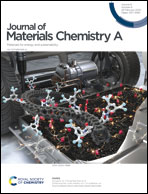Superior performance and stability of anion exchange membrane water electrolysis: pH-controlled copper cobalt oxide nanoparticles for the oxygen evolution reaction†
Abstract
The application of electrocatalysts with high activity to a practical water electrolysis cell is a crucial challenge for the production of pure hydrogen and commercialization of the water electrolyzer. Herein, a nanosized Cu0.5Co2.5O4 catalyst synthesized by co-precipitation by adjusting pH is applied to the anion exchange membrane water electrolysis (AEMWE) cell as an anode, which is demonstrated to have higher efficiency and stability than noble metal-based anodes. The composition (Cu/Co) and morphology of Cu0.5Co2.5O4 change as the pH increases and then nanoparticles are formed at pH 11, where oxygen vacancies are formed by the etching of Cu. In the density functional theory study, the electronic structure of Co modified by Cu in the Co3O4 lattice leads to an optimal adsorption strength, resulting in a free energy diagram in which the potential of Cu0.5Co2.5O4 (1.756 V vs. reversible hydrogen electrode, RHE) is more thermodynamically favorable than that of Co3O4 (1.951 V vs. RHE). The Cu0.5Co2.5O4 catalyst has a recorded overpotential of 285 mV at 10 mA cm−2 in 1 M KOH. Furthermore, the AEMWE cell using Cu0.5Co2.5O4 as an anode exhibited a current density of 1.3 A cm−2 at 1.8 V, which is the highest performance among the reported papers and maintains around 80% energy conversion efficiency for 100 hours.



 Please wait while we load your content...
Please wait while we load your content...